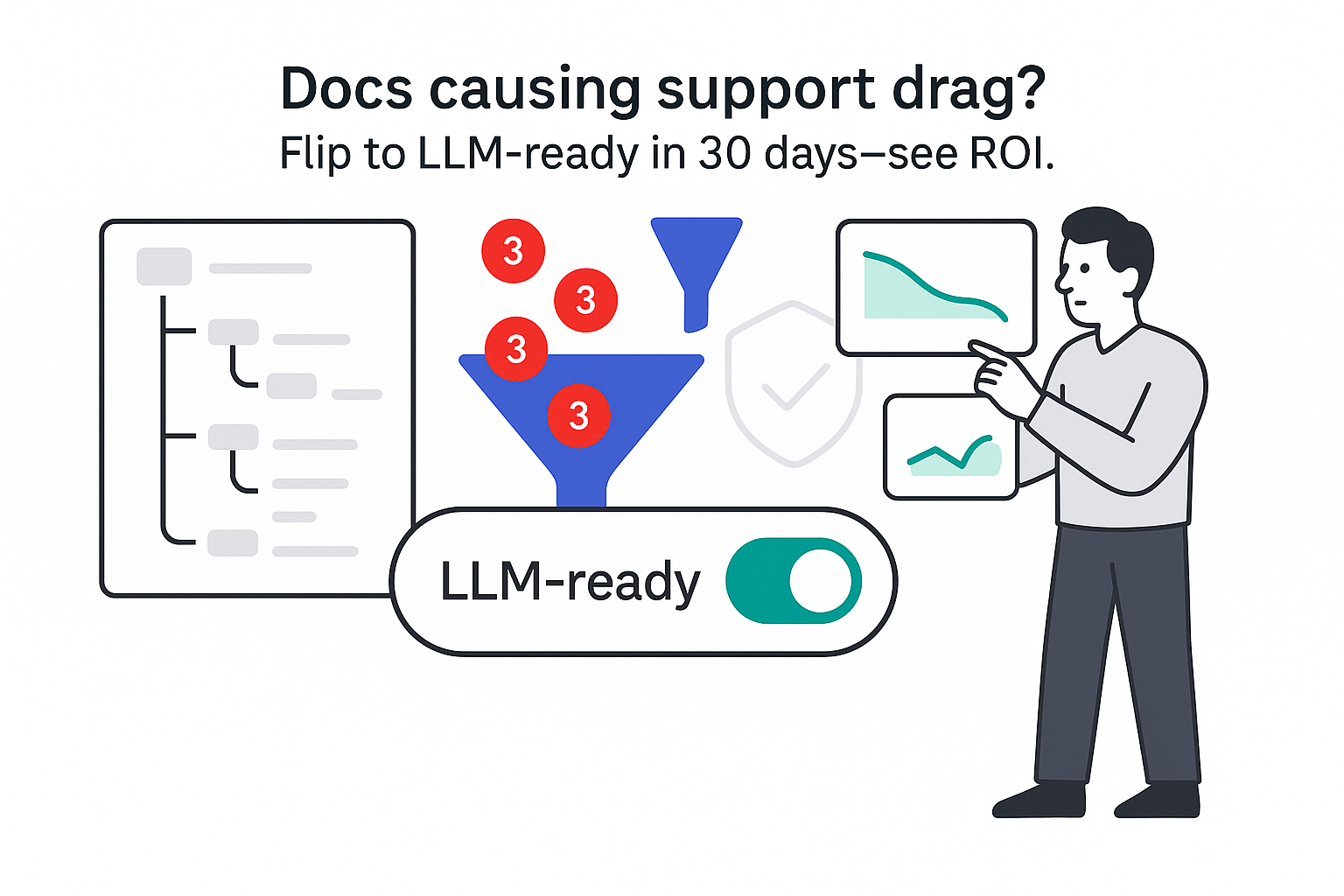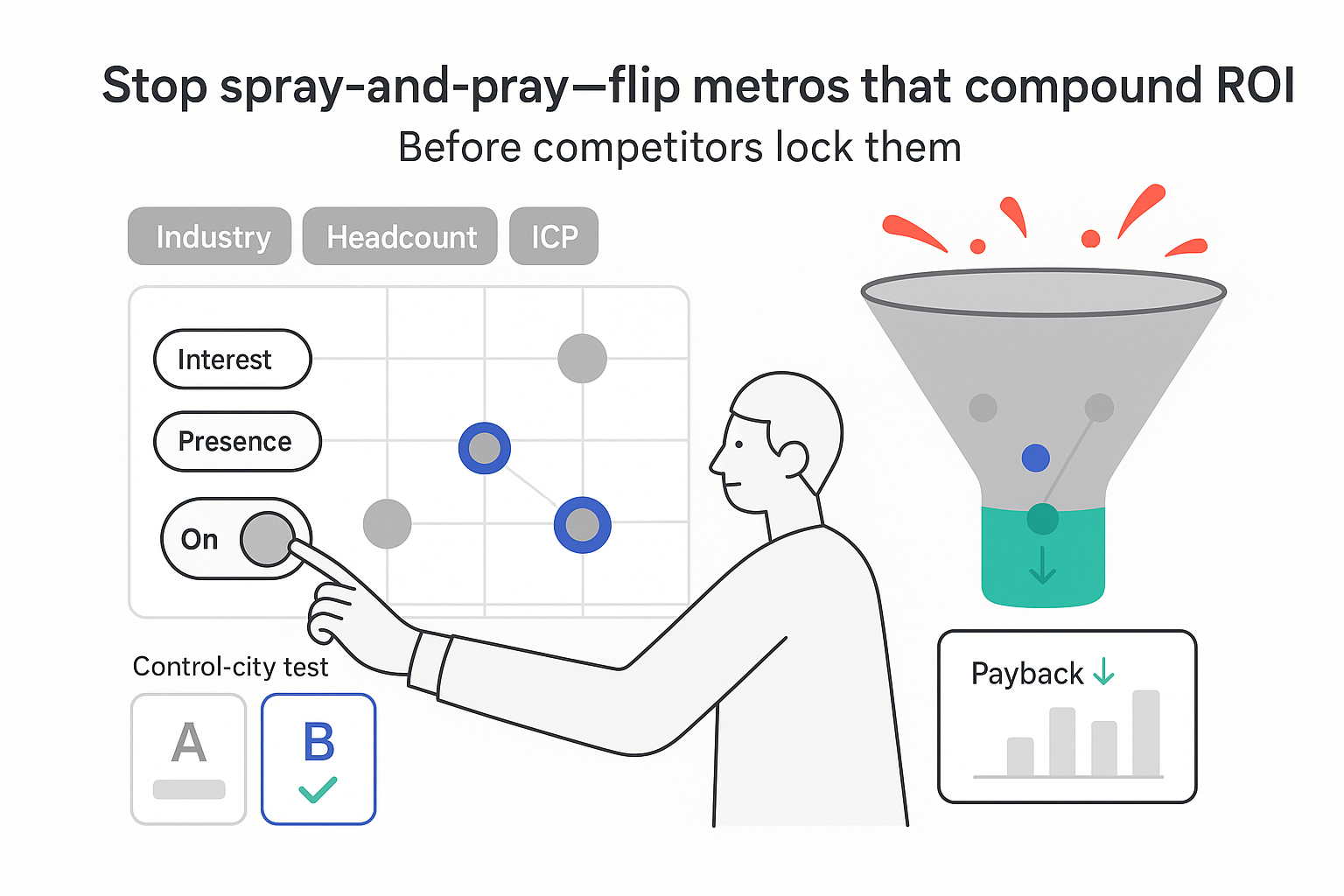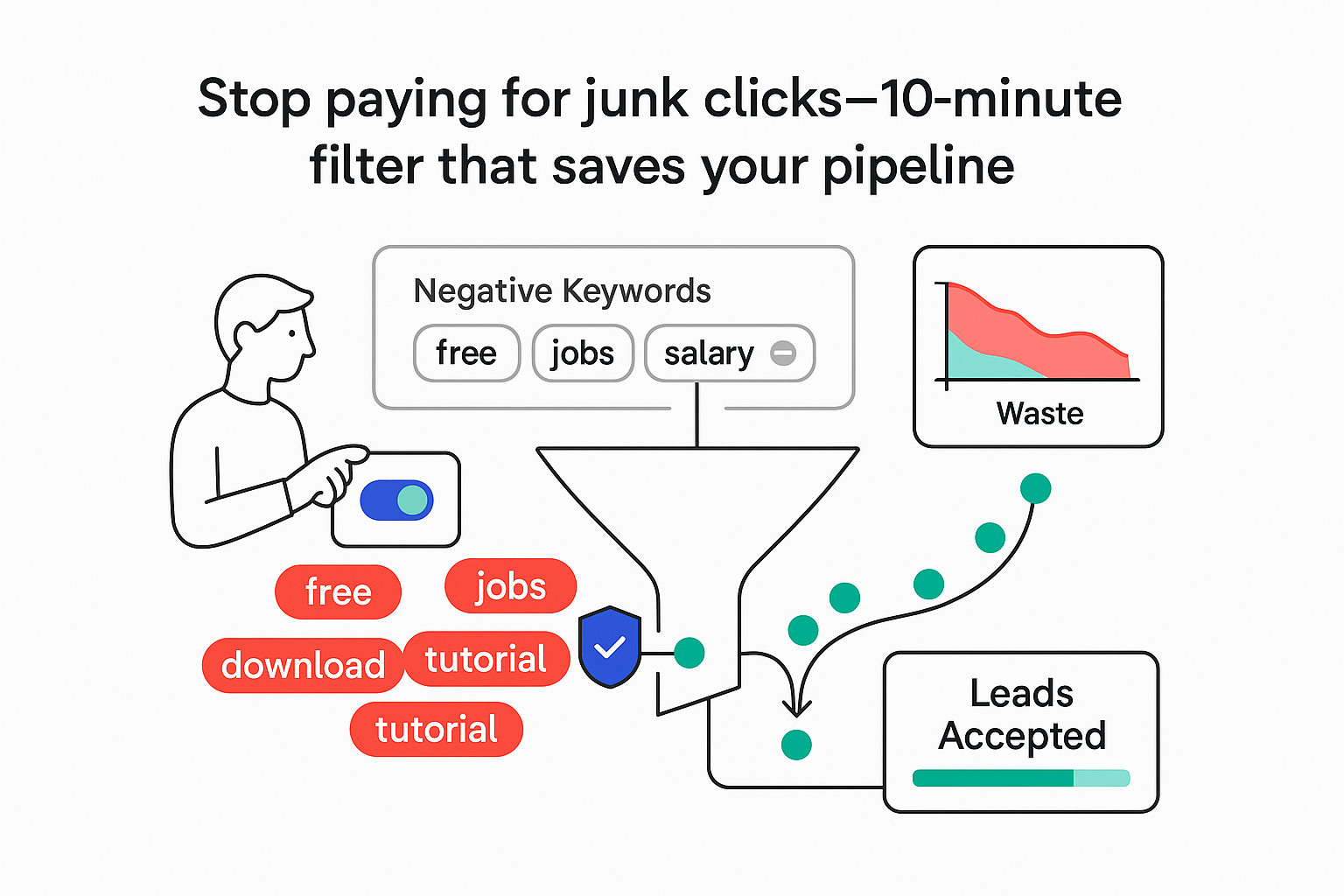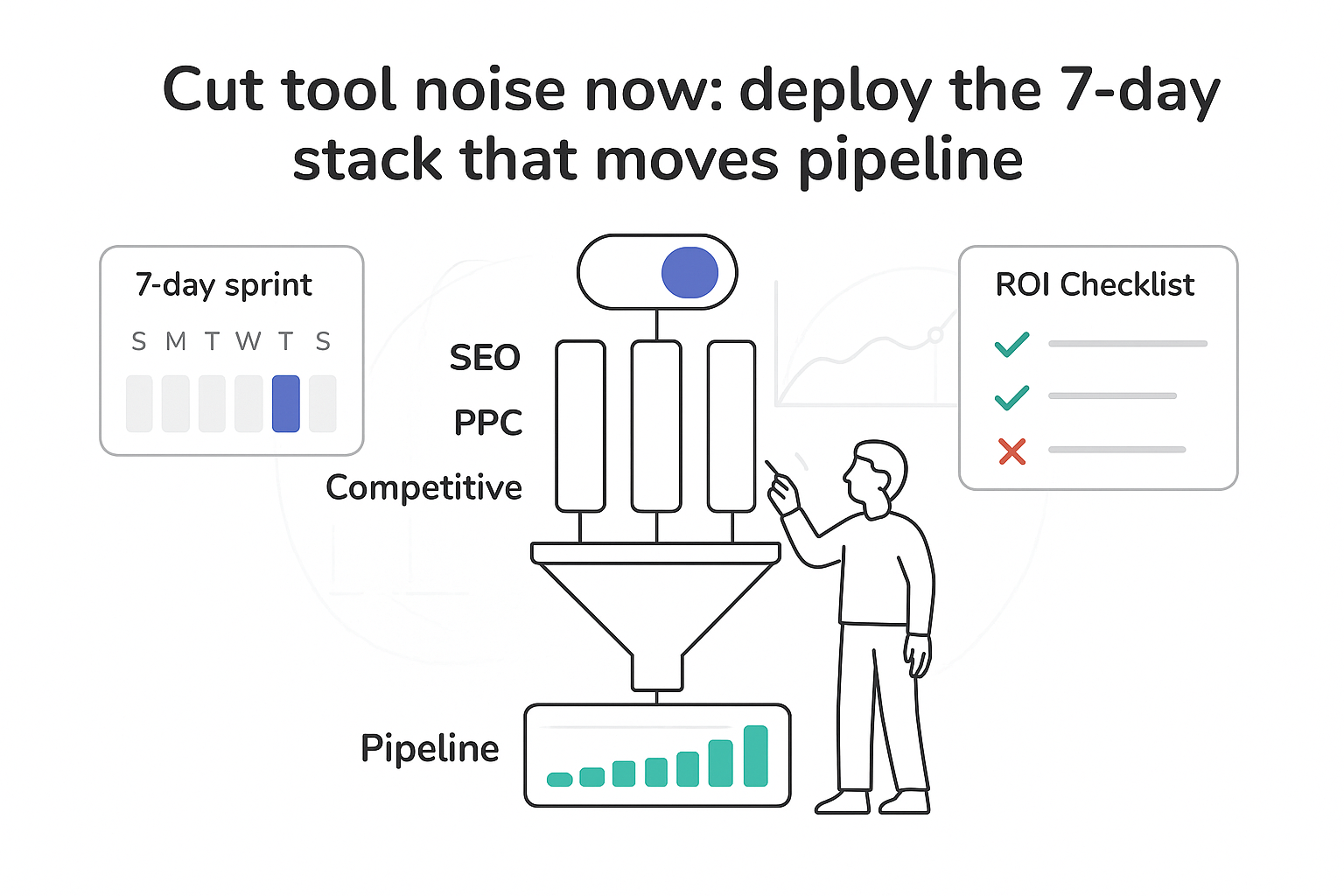If you run a B2B service company, I have seen documentation either save teams hours every week or send them into Slack scavenger hunts. The gap usually comes down to structure and ownership, not effort. Here is the good news. With practical LLM documentation practices in place, you can cut support tickets, speed up onboarding, and keep everyone speaking the same language. Nothing fluffy. Just clean inputs, reliable automations, and measurable outcomes.
LLM documentation
Busy leaders care about outcomes, not semantics, and I start there. When I standardize LLM-ready documentation, I typically see three quick wins within the first month (ranges are directional and depend on your baseline):
- Reduced support tickets by 20 to 35 percent because answers in docs are easier to find and trust.
- Faster onboarding by 25 to 40 percent since new hires get role-specific guides and quick starts.
- Higher org-wide consistency as AI assistants reuse the same terms, examples, and code patterns.
A simple before and after helps frame it.
Before:
- Docs live in different tools. Versions conflict. Engineers write one thing, sales reads another. Support leans on tribal knowledge. Tickets rise, and product teams repeat explanations.
After:
- A single repo powers all docs. Each page has metadata, anchors, and version tags. PRs generate previews. An AI documentation assistant drafts updates from code diffs. Support deflects common questions to clear pages that show up in search.
Here is what that means in dollar terms. If your support team handles 600 tickets per month and your loaded cost per ticket is 18 dollars, a 30 percent deflection saves about 3,240 dollars monthly. If onboarding a new engineer takes 6 weeks and you shave off 2 weeks, you reclaim 80 hours per hire. Across 10 hires this year, that is 800 hours back for work that moves revenue. Swap in your actual costs so the model reflects your reality.
For public examples of LLM-friendly documentation structure, see Svelte's llm guidelines, the Expo docs, and their LLM-friendly export of their docs.
A 30-day impact plan that fits into normal work
- Week 1: Pick one product area. Move its docs into a repo. Add front matter metadata and consistent headings. Set up preview builds on pull requests. Capture baselines for ticket volume and time to first success.
- Week 2: Configure a retrieval index over that content so your LLM can quote sources. Add anchors and canonical links.
- Week 3: Turn on a GitHub Action that turns PR descriptions into suggested doc updates. Run Vale for style and inclusive language.
- Week 4: Point support macros and sales playbooks to these updated pages. Track ticket deflection and time to first success against your baseline.
LLM documentation works best when I couple structure with automation. I set that foundation next.
technical documentation
Models read better when technical documentation is predictable. I make headings, front matter, and anchors consistent so a model can cite confidently.
A simple repo layout
docs/
_config/
vale.ini
styles/
Vocabulary.yml
Inclusive.yml
_includes/
snippets/
auth.md
pagination.md
_templates/
front-matter.yml
v1/
index.md
quickstart.md
guides/
integrating-crm.md
webhooks.md
api/
openapi.yaml
v2/
index.md
assets/
images/
diagrams/
scripts/
build-index.py
link-check.mjs
Front matter template I use
---
title: Webhooks for Events
description: Receive event notifications with retry logic and signed payloads.
version: 1.4
last_updated: 2025-01-07
audience: developer
tags: [webhooks, events, reliability]
canonical_url: https://docs.example.com/v1/guides/webhooks
anchors:
- id: signing-requests
text: Verify request signatures
- id: retry-policy
text: Understand retry behavior
related:
- /v1/guides/pagination
- /v1/api/#tag/Webhooks
---
What this gives your LLM:
- Clear titles and descriptions improve retrieval quality.
- Version flags reduce the chance a model mixes commands across releases.
- Canonical links prevent duplicate answers.
- Anchors create precise targets for citations.
Schemas I reuse
- YAML or JSON schemas for payloads and configs stored in a schemas/ folder.
- OpenAPI or GraphQL schema files live under api/.
- Example responses as small JSON files referenced from pages, not inline walls of text.
Chunking and anchors
- Keep sections short. Aim for 200 to 400 words with a single idea per section.
- Add level-3 anchors for every task. For example, h3 Verify request signatures or h3 Rotate API keys.
- Use consistent verbs: Install, Configure, Test, Troubleshoot. Models generalize patterns like this.
Guardrails that prevent surprises
- Avoid embedding secrets, tokens, or customer data in docs or indexes. Treat embeddings as data that must follow the same governance as the source.
- Use canonical links across versions. Every page in v2 should say where the v1 version lives and vice versa, so assistants recommend the correct path.
- Mark internal-only content with robots/noindex and access controls to keep private docs out of public search.
- If you publish public docs, consider an llms.txt file to signal machine-readable access. See a full version here.
AI documentation assistant
"Document as you code" works when I meet engineers where they already are. Pull requests carry context the AI can use to write docstrings, usage snippets, and change notes - without making anyone leave their editor.
Prompt that turns a diff into draft docs
You are an AI documentation assistant helping with developer docs.
Inputs:
- Pull request title and description
- Unified diff
- Current docs content at the related path
Rules:
- Write a short summary for the changelog.
- Propose updates to the relevant doc page using the same front matter and headings.
- Add at least one runnable code example and one curl example if applicable.
- Reference anchors and include version tags.
- Keep reading level around Grade 8 to 9. Avoid marketing terms.
Output:
- Changelog summary
- Suggested doc page patch in Git diff format
GitHub Action that comments with suggested docs
name: Docs from PR
on:
pull_request:
types: [opened, synchronize, reopened]
jobs:
draft_docs:
runs-on: ubuntu-latest
steps:
- uses: actions/checkout@v4
with:
fetch-depth: 0
- name: Collect context
run: |
echo "PR_TITLE<<EOF" >> $GITHUB_ENV
echo "${{ github.event.pull_request.title }}" >> $GITHUB_ENV
echo "EOF" >> $GITHUB_ENV
echo "PR_BODY<<EOF" >> $GITHUB_ENV
echo "${{ github.event.pull_request.body }}" >> $GITHUB_ENV
echo "EOF" >> $GITHUB_ENV
- name: Generate docs suggestion
env:
OPENAI_API_KEY: ${{ secrets.OPENAI_API_KEY }}
run: |
python scripts/build-doc-suggestion.py \
--title "$PR_TITLE" \
--body "$PR_BODY" \
--diff "$(git diff -U0 origin/${{ github.base_ref }}...HEAD)" \
> suggestion.md
- name: Comment on PR
uses: marocchino/sticky-pull-request-comment@v2
with:
path: suggestion.md
Examples that fit well here
- GitHub Copilot or JetBrains AI Assistant for inline docstrings and examples.
- Sourcegraph Cody to summarize large diffs.
- Semantic PR titles with Conventional Commits so the AI understands intent.
I always require human review before merging doc changes generated by an assistant, scope the bot to doc files, and keep an audit trail of which PR produced which text. If you need to convert repos into ingestible text for LLMs, try Gitingest.
automate documentation
Automation glues the whole system together. Your sources already describe the product. I put them to work.
Pipelines worth setting up
- OpenAPI to reference docs with Redocly or Docusaurus plugin-openapi.
- GraphQL schema to docs using tools like GraphDoc or SpectaQL.
- SDKs to API references with TypeDoc for TypeScript, Sphinx autodoc for Python, and Javadoc for Java.
- Changelog to release notes from Conventional Commits using Changesets or semantic-release.
- Nightly refresh jobs that rebuild embeddings for retrieval so the AI quotes fresh content. Framework options include LangChain and LlamaIndex.
A simple CI snippet for versioned docs
name: Docs CI
on:
push:
branches: [main, release/*]
schedule:
- cron: "0 3 * * *"
jobs:
build:
runs-on: ubuntu-latest
steps:
- uses: actions/checkout@v4
- name: Install
run: npm ci
- name: Build OpenAPI
run: npx redocly build-docs docs/v2/api/openapi.yaml -o public/v2/api.html
- name: Generate TypeDoc
run: npx typedoc --out public/sdk/ts ./sdk/ts
- name: Lint prose
run: npx vale docs/
- name: Build site
run: npm run build
- name: Publish preview
if: github.ref != 'refs/heads/main'
uses: netlify/actions/cli@v2
with:
args: deploy --dir=build --message="Preview for ${{ github.sha }}"
- name: Deploy to production
if: github.ref == 'refs/heads/main'
run: npx some-hosting-cli deploy build
embeddings:
runs-on: ubuntu-latest
needs: build
steps:
- uses: actions/checkout@v4
- name: Rebuild retrieval index
env:
VECTOR_API_KEY: ${{ secrets.VECTOR_API_KEY }}
run: python scripts/build-index.py --path ./docs --out ./index
Branching you can explain in one sentence
- Main for latest docs, release branches for frozen versions, and a docs-only branch for long-running edits that need previews shared with legal or enterprise customers.
I also add smoke tests that execute code blocks tagged as testable, plus secret scanning and link checks in CI, so examples do not rot and nothing sensitive leaks.
documentation quality
Good writing still wins. AI helps me keep tone, clarity, and glossary terms steady. I treat it as a safety net, not a voice replacement.
Tools that make quality stick
- Vale for style guide enforcement using custom rules and vocabulary lists.
- Alex for inclusive language checks.
- Readability checks with Hemingway or CLI tools like textstat.
- Linkinator or lychee to catch broken links.
- A shared glossary that both humans and the AI documentation assistant consult.
A Vale config I start with
# docs/_config/vale.ini
StylesPath = styles
MinAlertLevel = warning
Vocab = Docs
[*.md]
BasedOnStyles = Vale, WriteGood, Inclusive, Vocabulary
# docs/_config/styles/Vocabulary.yml
extends: substitution
message: "Prefer '%s' over '%s'."
level: warning
ignorecase: true
swap:
client: customer
whitelist: allowed list
blacklist: blocked list
# docs/_config/styles/Inclusive.yml
extends: alex
level: error
A review prompt I reuse
You are an editor for B2B technical docs.
- Keep Grade 8 to 9 reading level.
- Replace jargon with plainer terms where possible.
- Keep factual precision. Do not invent.
- Match the glossary. Prefer 'customer' not 'client'.
- Add one code block and one numbered example when helpful.
Return the revised paragraph and a 1 sentence rationale.
Before and after tone
Before: Our platform empowers users to seamlessly integrate and robustly scale their workflows.
After: Connect your system with one config file. Start with a sandbox key, send a test request, then move to live keys. If something fails, the response includes an error code and a fix.
The second version is clearer, kinder, and easier for models to map to user intent. Quality makes LLM documentation more reliable because it reduces ambiguity the model would otherwise guess about.
documentation insights
Docs should answer questions on their own, and they should also reveal what is missing. AI helps with both.
Make docs answerable
- Build a retrieval index over your docs with tools like LlamaIndex or LangChain.
- Add strict source citation rules so answers quote specific anchors.
- Use analytics from Algolia DocSearch or GA4 to pull common queries and build pages that meet those needs.
Find gaps with a simple rubric
- Every high-intent task should have a quick start, a full guide, a reference entry, and a troubleshooting section.
- Each guide should link to at least one runnable sample.
- Each reference should link to at least one guide that uses it.
- Every page should load in under two seconds and pass link checks.
- Each critical task should be answerable within three clicks or one search.
A 20-task validation set for any product
- Create an API key.
- Rotate an API key.
- Authenticate with OAuth.
- Refresh an OAuth token.
- Send a first request with curl.
- Handle pagination.
- Filter a list with query parameters.
- Create a resource in the sandbox.
- Move from sandbox to production.
- Validate request signatures.
- Retry on 429 or 5xx with backoff.
- Idempotency for POST requests.
- Webhook replay handling.
- Error code reference for top 10 errors.
- Rate limit policy and examples.
- SDK install for JavaScript.
- SDK install for Python.
- Migrate from v1 to v2.
- Common troubleshooting flow.
- Data residency and compliance notes.
Run an AI test on each task
- Ask your assistant the exact question, require a source, and check whether the step-by-step is complete and correct.
- If it fails or hedges, mark the doc as needing work and add an anchor or example.
- Re-run weekly to catch regressions after releases.
If you process logs or queries with a hosted LLM, I recommend a data-minimization pass and redaction of secrets or PII before any external calls.
audience customization
Not everyone needs the same page. Developers want commands and code. Designers want flows and examples. Executives want risk, cost, and time. I keep one source and generate variants to respect each need.
One source, many variants
- Keep a single markdown source with role hints in front matter.
- Use a build script that can produce developer, designer, and executive versions by including or excluding blocks.
- Or, instruct your AI documentation assistant to draft role-specific summaries pulled from the same page.
Front matter with audience and reading level
---
title: CRM Integration
description: Connect your CRM to sync contacts and deals.
audience_variants:
- developer
- designer
- executive
read_levels:
- technical
- business
---
Conditional content pattern
<!-- audience:developer -->
### Install and authenticate
1. Install the SDK
2. Set CRM_API_KEY as an env var
3. Run `node scripts/sync.js --dry-run`
<!-- audience:designer -->
### What the integration does
- Syncs contacts every 15 minutes
- Flags duplicates with a clear UI label
- Exports a CSV audit
<!-- audience:executive -->
### What to expect
- Initial setup takes about 2 hours
- Early sync volume: 50k contacts per day
- Risk: API quotas. Mitigation: backoff with retries
Reusable templates that speed things up
- Quick starts: a five-minute path with one working example and a success check.
- Integration guides: a clear flow, decision points, and rollback notes.
- ROI one-pagers: problem, approach, time saved per user, impact on tickets or cycle time.
documentation workflow
Change sticks when it lives in a process. A simple 30-60-90 day rollout works for most B2B teams I work with.
Days 1 to 30
- Audit one high-impact product area. Move its pages into the repo structure above.
- Add front matter, anchors, and canonical links.
- Build previews on PRs and set Vale checks to block merges on serious issues.
- Configure retrieval over the new content, then test five high-intent tasks.
- Record baselines for TTFX, ticket deflection, and top searches so you can measure lift.
Days 31 to 60
- Expand to two more product areas.
- Turn on the Docs-from-PR action across repos with code that touches public behavior.
- Wire support macros to the updated pages and retire duplicative wiki content.
- Start a biweekly review where one engineer and one PM own quality fixes.
Days 61 to 90
- Add nightly embedding rebuilds so LLM answers stay current.
- Introduce audience variants for developer and executive readers.
- Publish versioned docs for the last two releases with clear migration guides.
- Lock in quarterly OKRs tied to documentation KPIs.
Ownership and SLAs
- Name a Docs DRI who approves changes and owns metrics.
- Set SLAs for doc updates after code merges. For example, public-facing changes documented within three business days.
- Add risk controls for regulated content. For example, legal review on security pages and data handling.
Core KPIs that matter
- TTFX, time to first success: from landing on docs to first successful call.
- Ticket deflection rate: percentage of cases resolved by docs linked in replies.
- Organic traffic to docs: sessions and entrance rate to the docs section.
- Doc adoption in sales cycles: how often sales uses specific pages in deals.
- Readability and style pass rate: share of pages passing Vale and reading level checks on first review.
- LLM answer accuracy: percentage of questions answered with correct citations.
A brief note on tradeoffs. Automation can produce bland text if you let it run wild. I pair an AI documentation assistant with a human editor and a clear style guide. I keep examples real and avoid filler. That mild friction yields reliable, friendly pages people actually read.
Bringing it all together, I treat LLM documentation as a system. Structure fuels retrieval. Automations keep pace with code. Quality checks keep tone consistent. Insights show what to improve next. Tailored variants meet each reader where they are. And a steady workflow turns those parts into results you can measure. That is how documentation stops being a chore and starts paying for itself.







.svg)